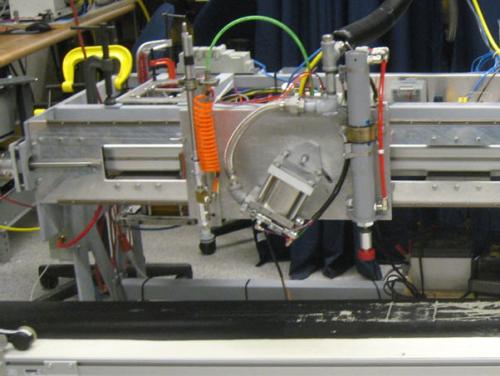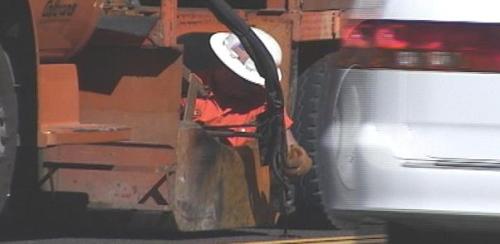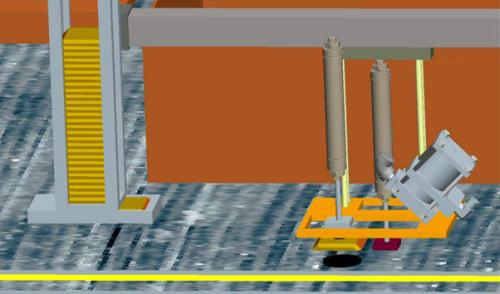
Automated Raised Pavement Marker Machine
link to pdf here.
| Outcome | Develop an automated raised pavement marker machine. |
| Benefit | Reduces the cost associated with raised pavement marker installation. Also, worker safety and injury prevention will be greatly improved. |
RPM machine prototype
RPM machine prototype Video 2
The Automated Raised Pavement Marker Machine project at AHMCT is aimed at the development of a system which can place Raised Pavement Markers (RPMs) in a more efficient cost-effective manner. A detailed search showed a lack of viable systems and existing equipment for cost-effective RPM placement devices that would meet Caltrans’ needs and thus led to the current project. AHMCT has focused on utilizing relatively inexpensive hardware and keeping the system as simple as possible in order to keep machine costs as low as possible. In addition to focusing on reducing RPM placement in terms of installation cost per marker, operator safety is considered a high priority as well. AHMCT researchers have developed and demonstrated a laboratory-based conceptual system that can install RPMs while maintaining continuous motion of the vehicle.
Why We Are Pursuing This Research?

RPM installation is a labor intensive process. The process is carried out in a stop-and-go fashion which causes excessive wear on the support vehicle. Additionally, the worker, who rides in the bucket of the truck, is exposed to many risks such as burn hazards, repetitive motion injuries, and being struck by other vehicles (See Figure 1). An automated raised pavement marker truck will be able to reduce installation costs as well significantly reduce the risk to workers. The current production rate for installing RPMs is about 1,200 markers/day. A system would have to move continuous speed of approximately 2 mph in order to meet this production rate.
What We Are Doing

The most difficult problems with any kind of RPM applicator system are that zero relative velocity with the road must be established, and that the adhesive and marker must located at the same position. The hand installation establishes zero relative velocity when the truck stops and the worker ensures that the marker and adhesive are collocated.
The concept developed by AHMCT allows the vehicle to move continuously. The concept uses a pneumatic band cylinder to accelerate the marker installation hardware relative to the truck. Once the carriage (consisting of the adhesive dispenser, friction foot, and marker placement apparatus) is accelerated to match the speed of the road, the fiction foot is deployed. The friction foot allows the road to drag the carriage along as the vehicle travels forward while the marker is installed. The foot establishes a target location and allows the system to handle small variations in vehicle speed. The fact that the marker applicator and the adhesive dispenser are rigidly connected to each other handles the collocation concern. Once the installation is done, the foot is retracted and the band cylinder is actuated to return the system to the home position where the carriage is reset for the next marker. Figure 2 presents a conceptual illustration of the system.

Once the concept and key system performance requirements were determined, AHMCT began developing a laboratory test stand. Since AHMCT has extensive experience dealing with bitumen from the TTLS projects, the adhesive melting system was not prioritized. AHMCT felt proving the method for establishing zero relative velocity was the critical path issue with the concept.
Verifying this part of the system was done by inverting the reference frame. In the field, the truck moves relative to the road. However, from a truck-based point of view, the road is moving relative to the truck. In the lab, this concept has allowed the utilization of a conveyer to represent the road and mounting the RPM installation system on a stationary platform. During the development of the test stand, efforts were made to ensure that the functional portion of the system could easily be transplanted onto another deployment platform (i.e., a trailer or truck). After building the test stand (shown in Figure 3) and developing the relevant control software, the placement operation was proven to be capable of placing RPMs on the conveyer at 2 mph.
Current Status
While not yet funded, the next phase of the project will initially focus on integrating the adhesive system. Implementing a hot bitumen system in the laboratory is not appropriate, therefore a trailer mounted unit with the capability of placing adhesive will be developed. The trailer unit will be able to take advantage of the modularity of the laboratory demonstration unit and utilize the same hardware. Once the adhesive system is incorporated, the trailer will be used for limited field testing. The machine’s capacity will be scaled up to approximately 150 markers. While below the 1,200 marker capacity necessary for ultimate deployment, this machine will provide sufficient capacity for proving effectiveness of the approach in the field. Once Caltrans is satisfied with the mechanics of the automated marker installation, AHMCT and Caltrans will work together to identify the final system platform and scale up the system to meet Caltrans’ production rate requirements.
For Additional Information
| Triet Bui Caltrans Project Manager | Triet.Bui (at) dot.ca.gov | (949) 756-4921 |
| Steven Velinsky Principal Investigator | savelinsky (at) ucdavis.edu | (530) 752-4166 |
| Duane Bennett Primary Contact | dabennett (at) ucdavis.edu | (530) 754-7401 |
This document is disseminated in the interest of information exchange. The contents do not necessarily reflect the official views or policies of the AHMCT Research Center, the University of California, the State of California, or the Federal Highway Administration. This document does not constitute a standard, specification, regulation, or imply endorsement of the conclusions or recommendations.
(rev. May 2007)
